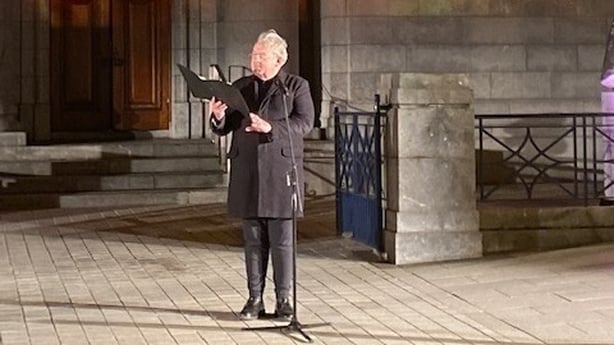Taoiseach Micheál Martin has urged people not to look back on the past with rose-tinted glasses but through "the measured eye of the discipline of history".
Mr Martin was speaking at a commemoration yesterday evening to mark the 100th anniversary of the burning of Cork by British forces on the night of 11 December 1920.
He said it was important that Irish people remember "the momentous events that occurred in Cork City and County during the struggle for freedom but that they also pay homage to the revolutionary generation who helped make Ireland one of the world's oldest continuous democracies.
"There are certain events in a nation's history that stand out in its struggle for independence. The burning of this City 100 years ago to this very evening is one such moment.
"It is embedded into the memory and consciousness of all Corkonians, and stands there along with the murder of MacCurtain and the hunger strike, death and funeral of MacSwiney, as elemental reminders of Cork's contribution to Ireland's struggle for independence."
The Taoiseach was among a small group including the City's Lord Mayor Councillor Joe Kavanagh, the City's Chief Fire Officer John Ryan, and writer Conal Creedon who took part in a ceremony were numbers were strictly limited to Covid-19 guidelines.
At 10.30pm, when the first building was reportedly torched in 1920, street and festive lights near City Hall were dimmed as images of flames were projected onto the riverside facade of the building marking a night when much of Cork City centre including Patrick Street was razed to the ground.
Fifty-seven department stores, shops and small businesses were looted and set on fire by RIC Auxiliaries who went on a rampage in retaliation for an IRA ambush on one of their patrols at Dillon's Cross earlier in the day.
The City Hall and the Carnegie Library were also burnt to the ground.
Read More:
Terror in Cork: the burning of a city
The fire caused an estimated €60m worth of damage in today's terms and took over a week to extinguish. Some 2000 people lost their jobs.
The Taoiseach said the Burning of Cork was an iconic moment in a period of great tumult and sacrifice but he warned that people should not look back at the past through rose-tinted glasses but through the measure of the discipline of history.
"We share an island where contested history, selective memory, and provocative assertions of identity can be barriers to mutual accommodation and the reconciliation necessary to our shared future."
Lord Mayor Councillor Kavanagh told the gathering that historians had identified Cork as the "cockpit of the Irish Revolution" and while the city and county accounted for just 9% of the population of the Island of Ireland in 1920, it accounted for 34% of all active IRA volunteers in the fight for freedom.
Chief Fire Officer John Ryan said he and the city's firefighters were privileged to follow in the footsteps of Captain Alfred J. Hutson and the 22 firefighters "who gallantly fought to control this conflagration on the streets of Cork.
"We can only stand in awe at their fortitude and bravery and we humbly salute them."
While no one died in the fires that swept through the city, three of the firemen on duty that night were injured.
Among those in attendance tonight was Kevin Higgins, a fifth-generation firefighter.
His great grandfather Martin Higgins and his great-great-grandfather Patrick Higgins were both on duty that night.

"They were both firefighters on the night of the Burning of Cork. Soldiers were slicing their hoses open and turning off the hydrants to stop the water flow at City Hall.
"They were also threatening the firemen who were putting out the flames. They were basically harassed and abused for the whole night. It was a very distressing event."
The ceremony finished with a lone piper playing "Beautiful City" after Cork writer Conal Creedon read an extract from Frank O'Connor's eyewitness account of the fire.
"Next morning when I wandered among the ruins, it was not the business district or the municipal buildings that I mourned for, but the handsome red-brick library that had been so part of my life from the time when as a small boy I brought back my first western adventure story over the railway bridges".
The ceremony can be viewed on www.corkcity.ie






